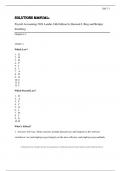SM 7-1
SOLUTIONS MANUAL:
Payroll Accounting 2024 Landin 34th Edition by Bernard J. Bieg and Bridget
Stomberg
M
Chapter 1-7
ED
Chapter 1
Which Law?
1. K
C
2. H
3. B
4. F
O
5. I
6. J
7. A
N
8. D
9. G
10. C
N
11. E
12. L
O
Which Payroll Law?
1. D
IS
2. A
3. F
4. C
5. G
SE
6. J
7. B
8. I
9. E
10. H
U
What’s Ethical?
1. Answers will vary. Some concerns include data privacy and integrity in the software
R
switchover, tax and employee pay integrity on the new software, and employee pay methods.
© McGraw Hill LLC. All rights reserved. No reproduction or distribution without the prior written consent of McGraw Hill LLC.
.
, SM 7-2
2. Answers will vary. Karsyn could choose to ignore her sorority sister’s request, claiming
Confidentiality. She could also discontinue active participation in the sorority. In any case,
Karsyn must not consent to her sorority sister’s request for confidential information.
M
Confidential Records
ED
As the payroll clerk, your task is to protect the privacy and confidentiality of the information you
maintain for the company. If a student group—or any personnel aside from the company’s
payroll employees and officers—wishes to review confidential records, you should deny their
C
request. If needed, you should refer the group to your department’s manager to discuss the matter
in more depth. The laws that apply to this situation are the Privacy Act of 1974, U.S. Department
O
of Health and Human Services Privacy Act 09-40-0006, Common-Law Privacy Act, Computer
N
Fraud and Abuse Act, and potentially HIPAA.
N
Large vs. Small
1. Large companies face issues with multiple departments, employee access to online
O
personnel portals, employee data security, and timekeeping accuracy.
IS
2. For small companies, payroll processing will involve fewer employees than for larger
companies. Smaller companies could maintain their payroll needs using company
SE
personnel because of the lower volume of transactions. Larger companies need to
consider their available trained payroll accountants and other staff to determine if they
can reliably handle the volume of payroll needs in a timely and accurate manner.
U
What Is the Difference?
R
© McGraw Hill LLC. All rights reserved. No reproduction or distribution without the prior written consent of McGraw Hill LLC.
.
, SM 7-3
a. Manual payroll systems involve the use of paper and pencil record-keeping or a
spreadsheet program, such as Microsoft Excel. This is most appropriate for very small
firms.
M
b. Computerized payroll systems can be used by any company, regardless of size. Examples
of computerized systems include QuickBooks, Sage 100, and Microsoft Dynamics 365
ED
GP. These computer packages range in price, depending on the company size and
operational scope.
c. Outsourced payroll involves the engagement of a third party to manage a company’s
C
payroll data, issue employee compensation, and prepare tax forms.
O
d. Certified payroll pertains to companies with employees who work on federal government
contracts. Certified payroll ensures that a company reports payroll expenditures of
N
contractually allocated money.
N
ANSWERS TO END-OF-CHAPTER MATERIALS
O
REVIEW QUESTIONS
1. What is the purpose of a payroll system?
IS
a. Provide for internal and external reporting of employee wages and associated taxes,
payment of employee compensation, and monitoring of benefits to employees. It also
SE
serves as a means of tracking labor costs that managers use for decision-making,
budgeting, and planning.
U
2. What are two differences between large- and small-company payroll practices?
a. Small companies would have fewer employees and reporting requirements and would
R
be less likely to be required to have automated payroll systems.
© McGraw Hill LLC. All rights reserved. No reproduction or distribution without the prior written consent of McGraw Hill LLC.
.
, SM 7-4
b. Large companies have more employees and greater departmentalization. This
increase in employees leads to a higher level of complexity in payroll accounting,
disbursements, and reporting. Larger companies may also provide Intranet portals for
M
employee self-service options. Additionally, larger companies may need additional
accuracy checks.
ED
3. What is certified payroll? Which companies must use it?
a. Certified payroll is a reporting requirement for companies that work with federal
C
contracts that are subject to Davis-Bacon wages. Only those companies that have
these types of employees would be required to complete a certified payroll.
O
4. Why might it be a good idea to let employees manage their payroll records? What are some
of the pitfalls?
N
a. An advantage of allowing individuals to self-manage their payroll records would be
N
the employee would be able to answer some simple questions on their own without
having to come to the payroll accountant for answers. If employees have access to
O
their payroll records, there would be the need to allow multiple access points to the
IS
confidential information. These open channels would require security settings to
ensure the requirements of confidentiality are maintained.
SE
5. What are two ways a payroll system may protect a company in the event of a visit from a
government auditor?
Answers may vary, but should contain:
U
a. The establishment and maintenance of an accurate payroll system. Timely and
R
accurately reporting wages and withholdings. Adherence to the legal framework of
payroll.
© McGraw Hill LLC. All rights reserved. No reproduction or distribution without the prior written consent of McGraw Hill LLC.
.




